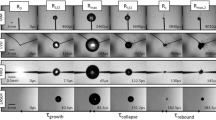Abstract
In several branches of science and technology a gaseous phase is dispersed into a liquid in the form of bubbles, a gaseous component then dissolves into the liquid and subsequently undergoes chemical reaction. The overall process performance can be improved substantially when the area of gas–liquid contact is increased. By subjecting the liquid phase to low frequency vibrations, the bubbles are shown to suffer significant breakage, induced by resonance. When the vibration is properly tuned, the interfacial area is found to increase by a factor of 1.8–2.4, depending on the properties of the liquid. Resonance-induced bubble breakage phenomena have a great potential for improving the rates of chemical processes involving fast reactions, with minimal energy input.
Similar content being viewed by others
Author information
Authors and Affiliations
Additional information
Received: 7 July 2000 / Accepted in revised form: 28 August 2000
Rights and permissions
About this article
Cite this article
Krishna, R., Ellenberger, J., Urseanu, M. et al. Utilisation of bubble resonance phenomena to improve gas–liquid contact. Naturwissenschaften 87, 455–459 (2000). https://doi.org/10.1007/s001140050758
Issue Date:
DOI: https://doi.org/10.1007/s001140050758




